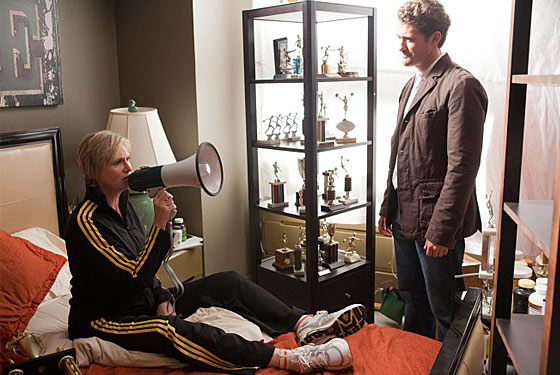
Uh-oh, are our early fears being realized? Just as Glee wraps up its critically acclaimed first season tonight, it is showing dangerous signs of encroaching Ryan Murphy syndrome, a corrosive ailment in which the writer creates a groundbreaking TV series with fascinating and provocative characters and plots that effectively combine fantasy and reality, only to push the show into a black hole of mind-numbing weirdness populated by sociopaths and freaks.
Murphy’s second TV series, Nip/Tuck, started showing symptoms toward the end of season two. (His first show, Popular, only lasted two seasons, but the seeds of destruction were beginning to sprout.) After fans embraced the fabulously daring, racy, and well-written show about two Miami plastic surgeons, they watched — at first with nervous discomfort, and soon outright dismay — as it jogged, then sprinted, into a soft-porn parody … for five more years. (Seriously, what was up with the serial killer who had no penis in season two?) The main characters — Drs. Christian Troy and Sean McNamara — started out as merely neurotic (one a narcissist, one a depressive), but by the end of season three they had devolved into grotesque cartoons. Murphy’s approach was like that of a comic who thinks, “If a joke works, then telling it again five times — loudly and more broadly — will make it work even better.”
And then came Glee, one of the most stunning and joy-filled debuts in recent TV memory, and it was embraced by a ravenous fan base almost from the moment the pilot first aired in May 2009. Even if a show that is gay in every sense of the word wasn’t your thing, it was hard to watch an episode without a smile on your face: The losers-are-winners premise, the cast of spectacular newcomers (at least to TV audiences), and the astonishingly good musical numbers were pretty much irresistible. Maybe it was that Murphy was distracted with directing Eat, Pray, Love while two of his Nip/Tuck deputies, Brad Falchuk and Ian Brennan, ran the new show, but it looked like he had licked his own syndrome.
Then came April’s Madonna episode — the first unavoidable red flag. It was a tour de force in terms of production, for sure, but it was also plainly a gimmick and a detour from the comparatively sincere and folksy first half of season one. The best episodes of Glee are perfectly poised between outrageousness and heart, and heart is beginning to lose. Indicative of this is the overreliance on Sue Sylvester. The divine Jane Lynch is one of the revelations of Glee, but she is becoming the victim of Murphy’s addiction to absurdity (that wince-inducing Olivia Newton John duet, for example) and his tendency to sacrifice character and plot for excess and shock value. Even Sylvester’s “Vogue” re-creation in the Madonna episode was something of a cheat: It didn’t add anything to her character — it wasn’t even in character — it was just a clip waiting to go viral, which it did. Ever since then, long-developing plots have been abandoned in favor of guest stars and gimmicks. The story lines behind Rachel and Jesse’s breakup and Quinn’s pregnancy (she was living at Puck’s house — wha?) were short-changed, leaving us with the out-of-nowhere egg-tossing animus of Jesse, and Mercedes inviting Quinn — when did they become friends? — to move in. Who has time for exposition when you can devote a third of an episode, and a musical number, to an illogical and faintly creepy faux seduction of Sue by Will Schuester?
Glee has been renewed by Fox. Very smart move. Here’s the bad news: Unlike this season, there is no four-month hiatus between the first and second half of season two; a dramatically more intense production schedule could aggravate Murphy’s worst instincts as there’s no time to step back and get some perspective. Furthermore, three new characters will be introduced; that, on top of the inevitable abundance of stunt casting, can only mean less time for coherent character development for the existing (and plentiful) cast. Here’s hoping that Eat, Pray, Love is a hit and reminds Murphy of the advantages of a grounded story. Then again, for all we know, in Murphy’s adaptation, Julia Roberts eats, prays, and loves with a crotchless serial killer.
Related: Overemote the Glee Way in These Three Easy Steps [Vulture]
The Five Best — And Five Worst! — Performances From Glee [Vulture]




